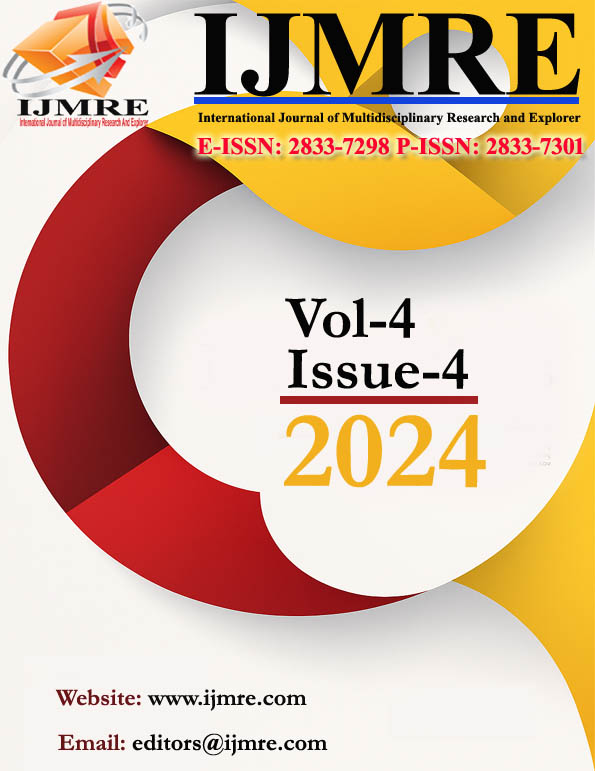Relationship between Purpose in Life and Psychological Distress among Older Adults
DOI:
https://doi.org/10.70454/IJMRE.2024.40402Keywords:
purpose in life, psychological distress, older adultsAbstract
The study investigates the relationship between psychological distress and purpose in life among older adults, along with gender differences in these variables. The sample consists of 80 older adults aged 65 to 79 years, selected from various parts of Kerala, primarily Palakkad, using a purposive sampling method to ensure equal representation of genders and minimize bias. The participants include 40 males and 40 females. Results reveal a significant negative correlation between purpose in life and psychological distress, indicating that higher purpose in life is associated with lower psychological distress. Furthermore, a t-test analysis shows no significant gender difference in purpose in life, suggesting similar perceptions of life purpose among male and female participants. However, a significant gender difference is observed in psychological well-being with females reporting higher levels of distress than males. These findings highlight the protective role of purpose in life against psychological distress and the need for gender-sensitive interventions to support older adults' mental well-being.
References
[1] Aldwin, C. M., & Igarashi, H. (2015). Successful, optimal, and resilient aging: A psychosocial perspective. APA Handbook of Clinical Geropsychology, Vol. 1: History and Status of the Field and Perspectives on Aging., 331–359. https://doi.org/10.1037/14458-014
[2] Alonso, V., Defanti, F. M. G., Neri, A. L., & Cachioni, M. (2023). Meaning and Purpose in Life in Aging: A Scoping Review. Psicologia: Teoria e Pesquisa, 39. https://doi.org/10.1590/0102.3772E39306.EN
[3] Asharani, P. V., Lai, D., Koh, J., & Subramaniam, M. (2022). Purpose in Life in Older Adults: A Systematic Review on Conceptualization, Measures, and Determinants. In International Journal of Environmental Research and Public Health (Vol. 19, Issue 10). MDPI. https://doi.org/10.3390/ijerph19105860
[4] Bonanno, G. A., Romero, S. A., & Klein, S. I. (2015). The Temporal Elements of Psychological Resilience: An Integrative Framework for the Study of Individuals, Families, and Communities. Psychological Inquiry, 26(2), 139–169. https://doi.org/10.1080/1047840X.2015.992677
[5] Boylan, J. M., Tsenkova, V. K., Miyamoto, Y., & Ryff, C. D. (2017). Psychological resources and glucoregulation in Japanese adults: Findings from MIDJA. Health Psychology, 36(5), 449–457. https://doi.org/10.1037/HEA0000455
[6] Cacioppo, S., Grippo, A. J., London, S., Goossens, L., & Cacioppo, J. T. (2015). Loneliness: Clinical Import and Interventions. Perspectives on Psychological Science, 10(2), 238–249. https://doi.org/10.1177/1745691615570616
[7] Celano, C. M., Albanese, A. M., Millstein, R. A., Mastromauro, C. A., Chung, W. J., Campbell, K. A., Legler, S. R., Park, E. R., Healy, B. C., Collins, L. M., Januzzi, J. L., & Huffman, J. C. (2018). Optimizing a Positive Psychology Intervention to Promote Health Behaviors after an Acute Coronary Syndrome: The Positive Emotions after Acute Coronary Events III (PEACE-III) Randomized Factorial Trial. Psychosomatic Medicine, 80(6), 526 534. https://doi.org/10.1097/PSY.0000000000000584
[8] Cohen, R., Bavishi, C., & Rozanski, A. (2016). Purpose in life and its relationship to all cause mortality and cardiovascular events: A meta-analysis. Psychosomatic Medicine, 78(2), 122–133. https://doi.org/10.1097/PSY.0000000000000274
[9] Crowther, M. R., Parker, M. W., Achenbaum, W. A., Larimore, W. L., & Koenig, H. G. (2002). Rowe and Kahn’ s model of successful aging revisited: Positive spirituality - The forgotten factor. Gerontologist, 42(5), 613–620. https://doi.org/10.1093/GERONT/42.5.613
[10] Crumbaugh, J. C., & Henrion, R. P. (1988). The Purpose in Life Test: A contemporary assessment of Frankl’s concept of purpose. Journal of Clinical Psychology, 44(3), 377 387. https://doi.org/10.1002/1097-4679(198805)44:33.0.CO;2-4
[11] Dewitte, L., & Dezutter, J. (2021). Meaning Reflectivity in Later Life: The Relationship Between Reflecting on Meaning in Life, Presence and Search for Meaning, and Depressive Symptoms in Older Adults Over the Age of 75. Frontiers in Psychology, 12, 726150. https://doi.org/10.3389/FPSYG.2021.726150/BIBTEX
[12] Life Diener, E., Emmons, R. A., Larsen, R. J., & Griffin, S. (1985). The Satisfaction With Scale. Journal of Personality 75. https://doi.org/10.1207/s15327752jpa4901_13
[13] decades Diener, E., Suh, E. M., Lucas, R. E., & Smith, H. L. (1999). Subjective well-being: Three of progress. Psychological https://doi.org/10.1037/0033-2909.125.2.276
[14] Bulletin, 125(2), 276–302. Golovchanova, N., Owiredua, C., Boersma, K., Andershed, H., & Hellfeldt, K. (2021). Presence of Meaning in Life in Older Men and Women: The Role of Dimensions of Frailty and Social Support. Frontiers in Psychology, 12. https://doi.org/10.3389/fpsyg.2021.730724
[15] Kessler, R. C., Andrews, G., Colpe, L. J., Hiripi, E., Mroczek, D. K., Normand, S. L., Walters, E. E., & Zaslavsky, A. M. (2002). Short screening scales to monitor population prevalence and trends in non-specific psychological distress. Psychological Medicine, 32(6), 959–976. https://doi.org/10.1017/S0033291702006074
[16] Kim, E. S., Tkatch, R., Martin, D., MacLeod, S., Sandy, L., & Yeh, C. (2021). Resilient Aging: Psychological Well-Being and Social Well-Being as Targets for the Promotion of Healthy Aging. Gerontology and Geriatric 7.
[17] Pfund, G. N. (2020). We meet again: The reintroduction and reintegration of purpose into personality psychology. The Ecology of Purposeful Living Across the Lifespan: Developmental, Educational, and Social Perspectives, 11–28. https://doi.org/10.1007/978 3-030-52078-6_2
Downloads
Published
Issue
Section
License
Copyright (c) 2024 SHIMIL (Author)

This work is licensed under a Creative Commons Attribution 4.0 International License.
This is an Open Access article distributed under the term's of the Creative Common Attribution 4.0 International License permitting all use, distribution, and reproduction in any medium, provided the work is properly cited.







